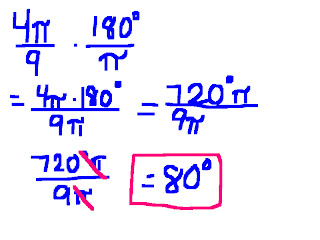To convert degrees to radians you need to multiply the degree by π and divide by 180. For example when turning 200 degrees into radians
Tuesday, April 30, 2013
How to convert between radian & degree?
To convert from radians to degrees, multiply by 180/pi. For example when turning 4pi/9 to degrees
Why is the name Pythagorean identity appropriate?
Pythagorean Identity is an appropriate name because its the identity that is associated with Pythagorean theorem. Your trying to find a side of a triangle. The Pythagorean identity is sin^2 + cos^2 =1. The Pythagorean theorem is a^2 + b^2 = c^2
How to find Arc length of a circle?
When finding the arc length of an angle you divide the angle measure by 360. Then you multiply that by 2, pie, and the radius.
Sunday, January 13, 2013
How do we simplify complex fractions?
Complex fractions is a fraction within a fraction. For example 1 over 1/3. Step one would be to rewrite it as 1 divided by 1/3. Step two would be to convert to a multiplication problem that would be 1*3. the answer would be 3.
Monday, January 7, 2013
How do we add and subtract rational expressions?
When adding and subtracting rational expressions you need to get the same denominator. For example if your problem is 2/x+1 + 9/x-1. You would multiply the first fraction by x-1 top and bottom. What ever you do to the denominator you MUST do to the numerator. That fraction now becomes 2x-2/x^2-1. The second fraction you would multiply the top and bottom by x+1. That now becomes 9x+9/x^2-1. Now that they share the same denominator you can began solving. You now have 2x-2 + 9x+9/x^2-1. The 2x+9x becomes 11x and -2+9 equals 7. Your final answer is 11x+7/x^2-1.
How do we multiply and divide rational expressions?
When multiplying rational expressions alot of things usually cancel out. For example if you have a/b times b/a the a and b would both cancel. When the a cancel each other out that would become one. when the b cancel it that would also become one. you are now left with 1 times 1 so your final answer would be 1. A could not equal to 0 and neither can b due to the fact that 0 can not be in the denominator. When dividing rational expressions the operation sign changes and the second fraction flips. For example say if your problem is 1/x divided by 1/2x , you would keep the first fraction the way it is. You when then change the division sign to a multiplication sign and flip the 1/2x. Your new problem is now 1/x times 2x/1. You multiply straight across and get 2x/x. the x's cancel each other and your final answer is 2.
Subscribe to:
Comments (Atom)



